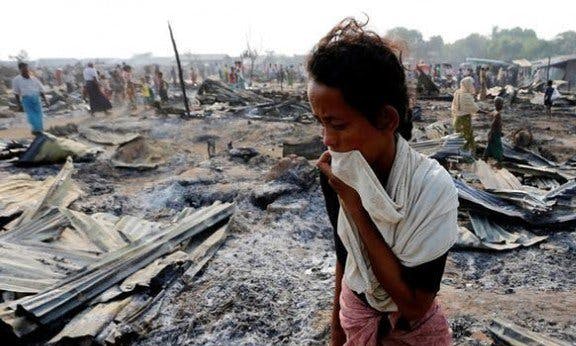Rohingyas driven out of Myanmar

More than 100,000 Rohingyas (a predominantly Muslim ethnic group in Myanmar) have been driven out of their ancestral villages and into Bangladesh, fleeing for their lives while their houses have been burnt to the ground.
Desperate survivors recounted incendiary rockets being fired from military helicopters; videos shot from across the border showed columns of billowing smoke, and satellite imagery revealed that villages along a 100-kilometre stretch have been almost totally destroyed.
Refugees told harrowing stories of hacking killings, beheadings and rapes carried out not only by soldiers and police but also by armed civilians reported to be from the predominantly Buddhist Rakhine ethnic group from the same area (Rakhine state, formerly known as Arakan).
This latest and most extreme episode in the decades-long persecution of the Rohingyas was purportedly sparked by attacks by militants from the Arakan Rohingya Salvation Army (ARSA) on 25 August, but these followed weeks of increasing intimidation. ARSA claims to have acted in self-defence as hundreds of troops were airlifted into Rakhine state, surrounding and closing in on them.
The ethnic cleansing also coincided with the release on 24 August of a report into the Rakhine situation by a commission appointed by the government. The commission, headed by former UN secretary general Kofi Annan, included not a single Rohingya member. Yet, like many other observers, it warned of an upsurge in violence if a range of underlying conditions in Rakhine were not addressed.
While both Rakhine and Rohingya inhabitants have faced the hardships of living in this poorest state in Myanmar, the Rohingyas have additionally and increasingly been persecuted through denial of their status as citizens and legitimate residents of the country.
A Citizenship Law passed in 1982 excluded them from consideration as a recognised ethnicity; in recent years they have been forced to hand over the residence registration papers they had been issued. And in a census held last year they were denied the right to register as “Rohingya”, being allowed only the choice of being recorded as “Bengali” (thereby declaring themselves foreigners).
These legal restrictions and accompanying discrimination and persecution (in major waves of violence starting in 1972 and most recently in October 2016) have resulted in 50 percent of the Rohingya population fleeing Myanmar, leaving behind 1 million of their people facing an increasingly precarious situation. Neighbouring Bangladesh was already hosting 400,000 Rohingya refugees before this recent exodus.
Despite the much-proclaimed end of Myanmar’s military regime in 2015 with the election of a majority in parliament for the National League for Democracy led by former political prisoner Aung San Suu Kyi, the military has continued to hold the reins. Aung San Suu Kyi’s civilian government has turned its back on the expectations of many non-Burman ethnic groups in the country, who supported the NLD in the hope that its victory might open a new page of inclusiveness.
While representatives of the diaspora, chiefly in Europe and the UK, and their supporters as well as a number of serious researchers have in recent years repeatedly tried to draw attention to the unbearable and rapidly deteriorating situation, only this most recent dramatic escalation in violence and refugee outpouring has attracted a serious response, starting with the Islamic majority countries of Malaysia, Turkey, Iran, Indonesia, Pakistan, the Maldives and Bangladesh as well as various Gulf countries and the Organisation of Islamic Cooperation. Even the UK foreign minister has spoken out.
Bangladesh, itself facing tremendous problems of poverty and climate change, and now one-third under water due to recent monsoon floods, initially refused entry to this new influx of refugees. In recent days it appears to have allowed their entry, with more than 80,000 so far having escaped from the terror.
Will they ever be able to return home? And having lost so many relatives, friends and neighbours as well as their homes, livestock and possessions, will they want to return even if the killing stops?